Focus on fellowship for Pulitzer winners
A technician in a cherry picker works in Times Square as NBC’s Tim Russert reports on the grand jury testimony in the impeachment proceedings of President Bill Clinton. (Robert Bukaty, The Associated Press)
When Robert Bukaty ’82 was growing up, he accompanied his father, a photographer for the Buffalo Courier-Express, on photo assignments.
One of them was the 1980 Winter Olympics in Lake Placid. Bukaty had just been accepted to RIT and his dad agreed to cover the Olympics if he could bring his son along.
“We shared a house with all of these photographers,” Bukaty remembers. “There were photographers sleeping on the floor, sleeping near the wood stove. At the end of the day of shooting the Olympics, photographers always got together, even though they competed against each other all day long.”
Maybe that’s why Bukaty and six other RIT alumni—all Pulitzer Prize-winners—enjoyed being together for the first time as much as receiving an honor for their work.
The seven men, ranging in age from 39 to 59 years old, were given the Isaiah Thomas Award in Publishing on Sept. 22.
The award recognizes those who’ve made outstanding contributions to the publishing industry. RIT’s School of Print Media hosted the awards ceremony at the Newseum in Washington, D.C.
The award recipients were Bukaty, Paul Benoit ’76, Ken Geiger ’11, Stan Grossfeld ’73, Dan Loh ’95, William Snyder ’81 and Anthony Suau ’78. All graduated from RIT’s School of Photographic Arts and Sciences.
“It’s quite a distinguished class,” says Grossfeld, an associate editor at The Boston Globe. “It’s a pleasure to be honored with them. These guys are all eclectic, tremendous human beings because of what they have gone through to get these pictures. It bonds us. We are like brothers. And not because of the Pulitzer Prizes, but because of the nature of what we do.”
What the seven graduates have done throughout their careers is win a combined 11 Pulitzer Prizes in photojournalism. Their images have documented the best and worst of humanity. Their work is part of an exhibit at the Newseum featuring 1,000 Pulitzer Prize-winning photos along with video and audio interviews of the winners.
And as storytellers, these photojournalists have often put themselves in harm’s way. Grossfeld risked his life to cover the war in Lebanon in 1983, taking photographs of firefights in Tripoli and Beirut.
“I remember in Beirut when I checked in to the hotel, they asked me if I wanted to be in a room on the car bombing side or the rocket side,” he says. “So that’s a bad memory.”
Just two years out of college and working as a staff photographer at the Boston Herald-American, Benoit found himself in the middle of the one of the biggest news events of the decade. The Blizzard of ’78 had paralyzed the Northeast. Scanner reports declared there was a tidal surge in the town of Revere, Mass., outside of Boston, and people were trapped. Benoit, unable to get a ride with the National Guard because it was deemed too dangerous, decided to go on foot.
“I had this brilliant idea to walk,” Benoit says. “I went with an Associated Press photographer who was the only person I could find willing to make the trek with me. It took us about seven hours to get through the snow and waste-deep slush. The worst part was when we got there the flash on my camera didn’t work. I started knocking on doors of an apartment building and a woman finally let me in. I put my camera in her oven for about 20 minutes and that did the trick.”
Future photojournalists were among those in the audience who heard the stories behind the photos.
Undergraduate and graduate students from RIT’s School of Photographic Arts and Sciences and School of Print Media traveled to D.C. for the event.
Elizabeth Stallmeyer, a third-year photojournalism student from Lincroft, N.J., says she was captivated by how Benoit got the blizzard photos. She sat with him at lunch.
“He emphasized that we have to work hard, be curious and remain persistent to succeed in this business,” she says. “Paul also told us to take advantage of the great professors and amazing facilities at RIT.”
During his acceptance speech, Grossfeld praised the photojournalism students.
“I’m so impressed by your work ethic,” says Grossfeld. “We need a real democracy. We need trained observers to tell the real story. You are all going to do far better than me. I guarantee it.”
Bonded by their craft and their alma mater, all seven men praised the caliber of the education they received at RIT.
“The years that I spent at RIT really defined my career and my professionalism,” Suau says. “What I learned there has stayed with me throughout my career and has had an enormous influence on how I work and how I view the world.”
To see a photo gallery from the event, go to www.rit.edu/news and click on photo gallery archive at the bottom righthand side of the page.
About the photographers
Paul Benoit ’76 won the Pulitzer Prize in 1979 in the Feature Photography category while working for the Boston Herald-American. Benoit and members of the paper’s photography staff won for their coverage of the Blizzard of 1978. Benoit currently serves as the chief operating officer for MerlinOne Inc. in Quincy, Mass.
Robert Bukaty ’82 won the Pulitzer Prize in 1999 while working for The Associated Press. Bukaty and fellow RIT alumnus Dan Loh were part of the AP photography staff honored in the Feature Photography category for their series of images of the key players and events surrounding President Bill Clinton’s affair with Monica Lewinsky and the impeachment hearings. Bukaty continues to work for The Associated Press, based out of the Portland, Maine, bureau.
Ken Geiger ’11 won the Pulitzer Prize in 1993 while working for The Dallas Morning News. Geiger and William Snyder, an RIT alumnus who is currently the program chairman of RIT’s photojournalism program, won in the Spot News Photography category for their images of the 1992 Summer Olympics in Barcelona, Spain. Geiger is deputy director of photography at National Geographic magazine. He joined the staff of National Geographic in 2004 after 24 years of working in newspaper journalism. Geiger attended RIT in the late 1970s, but left for a job just a couple of classes short of graduating. He was awarded his degree this year.
Stan Grossfeld ’73 won two Pulitzer Prizes in 1984 and 1985 while working for The Boston Globe. Grossfeld won in 1984 in the Spot News category for his series of photographs revealing the effects of war on the people of Lebanon. In 1985, he earned a Pulitzer in the Feature Photography category for a portfolio of images of the famine in Ethiopia and of illegal aliens on the Mexican border. Grossfeld was also among the finalists for Pulitzers in 1984, 1994 and 1996. Grossfeld was named associate editor of The Boston Globe in 1987.
Dan Loh ’95 won the Pulitzer Prize in 1999 in the Feature Photography category while working for The Associated Press for his coverage of the Monica Lewinsky scandal. Loh currently works in New York City as a photographer covering wedding, portrait, corporate and editorial assignments.
William Snyder ’81 won four Pulitzer Prizes in 1989, 1991, 1993 and 2006, while working for The Dallas Morning News. Snyder was honored in 1989 in the Explanatory Journalism category. Snyder was part of a three-person team that reported how the National Transportation Safety Board conducts air-crash investigations following a crash in 1986. In 1991, Snyder won a Pulitzer in the Feature Photography category for his images of ill and orphaned children living in deplorable conditions in Romania. Snyder and Geiger won in the Spot News category in 1993 for their images of the 1992 Summer Olympics in Barcelona. Under Snyder’s leadership as director of photography at The Dallas Morning News, the staff earned a Pulitzer in 2006 in the Breaking News Photography category for its coverage of Hurricane Katrina. Snyder returned to RIT in 2008 and is a professor and program chair of the university’s photojournalism program.
Anthony Suau ’78 won the Pulitzer Prize in 1984 for Feature Photography while at The Denver Post, for a portfolio of images depicting the tragic effects of starvation in Ethiopia and for a single photograph of a woman at her husband’s gravesite on Memorial Day. Suau is an Emmy award-winning photojournalist and author based out of New York. In 2009, he co-founded Facing Change: Documenting America, a collective of 10 prominent American photographers set out to document the U.S. in the enduring economic crisis.
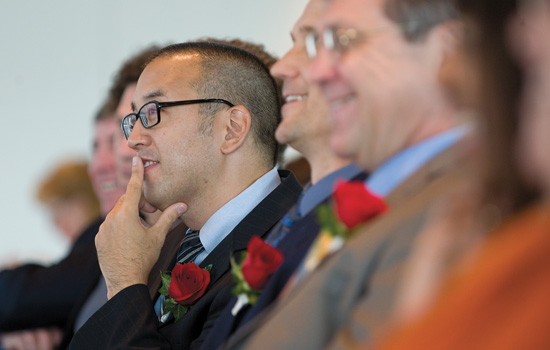 Dan Loh listens to the presentatation with fellow award recipients. A. Sue Weisler
Dan Loh listens to the presentatation with fellow award recipients. A. Sue Weisler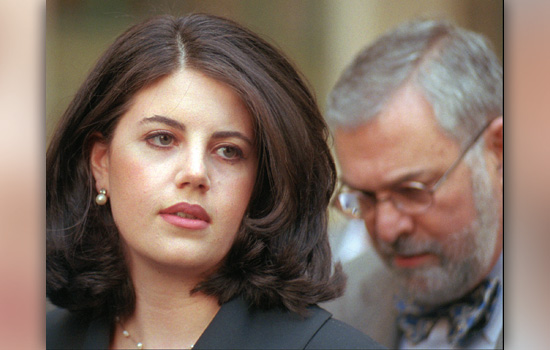 Former White House intern Monica Lewinsky and her attorney William Ginsburg. (Dan Loh, The Associated Press)
Former White House intern Monica Lewinsky and her attorney William Ginsburg. (Dan Loh, The Associated Press)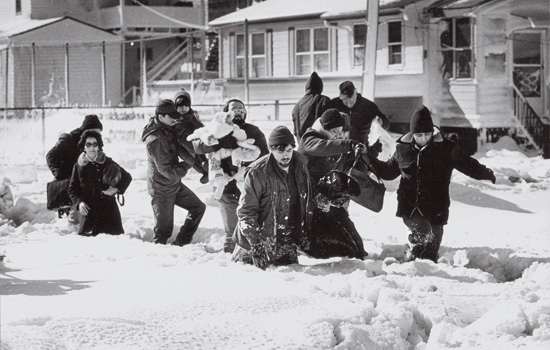 Paul Benoit walked 10 miles to Revere, Mass., at the height of the Blizzard of 1978 to photograph the rescue of 1,000 people. (Benoit, Boston Herald-American)
Paul Benoit walked 10 miles to Revere, Mass., at the height of the Blizzard of 1978 to photograph the rescue of 1,000 people. (Benoit, Boston Herald-American)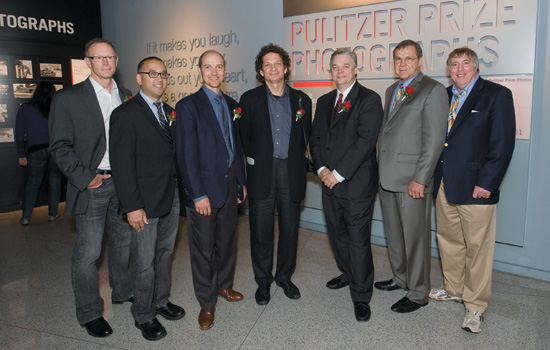 Seven RIT alumni—all Pulitzer Prize winners—received the Isaiah Thomas Award in Publishing on Sept. 22. The award, named for one of America’s great patriot printers, is presented annually by RIT’s School of Print Media. Alumni recognized, from left to right, are Ken Geiger, Dan Loh, Robert Bukaty, Anthony Suau, William Snyder, Paul Benoit and Stan Grossfeld. The photographers gathered for the first time at the awards ceremony in Washington, D.C. A. Sue Weisler
Seven RIT alumni—all Pulitzer Prize winners—received the Isaiah Thomas Award in Publishing on Sept. 22. The award, named for one of America’s great patriot printers, is presented annually by RIT’s School of Print Media. Alumni recognized, from left to right, are Ken Geiger, Dan Loh, Robert Bukaty, Anthony Suau, William Snyder, Paul Benoit and Stan Grossfeld. The photographers gathered for the first time at the awards ceremony in Washington, D.C. A. Sue Weisler U.S. diver Mary Ellen Clark dives to a surprise bronze medal in the 1992 Summer Olympic Games in Barcelona, Spain. (William Snyder, The Dallas Morning News)
U.S. diver Mary Ellen Clark dives to a surprise bronze medal in the 1992 Summer Olympic Games in Barcelona, Spain. (William Snyder, The Dallas Morning News)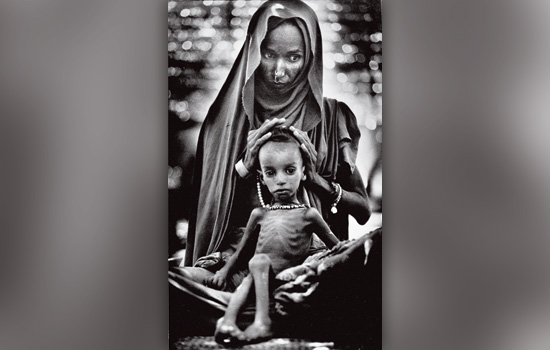 Stan Grossfeld traveled to Ethiopia to document the effects of famine and drought. He captured this photo of an African Madonna holding her child just hours before the child died. (Grossfeld, The Boston Globe)
Stan Grossfeld traveled to Ethiopia to document the effects of famine and drought. He captured this photo of an African Madonna holding her child just hours before the child died. (Grossfeld, The Boston Globe)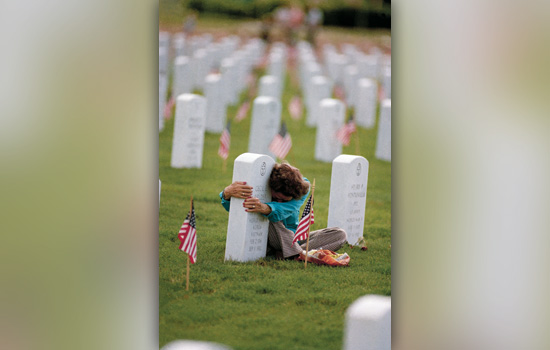 A grief-stricken widow clings to her husband’s tombstone on Memorial Day. (Anthony Suau, The Denver Post)
A grief-stricken widow clings to her husband’s tombstone on Memorial Day. (Anthony Suau, The Denver Post)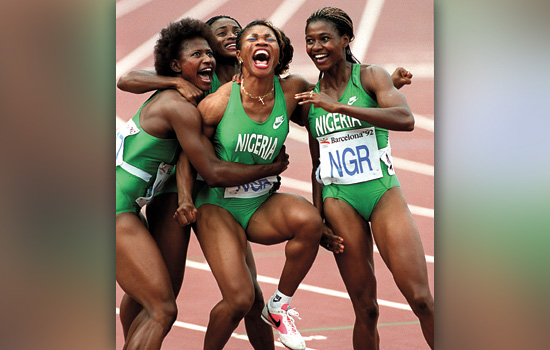 Nigeria’s 4 x 100 Meter Women’s Relay Team wins bronze at the 1992 Summer Olympic Games. (Ken Geiger, The Dallas Morning News)
Nigeria’s 4 x 100 Meter Women’s Relay Team wins bronze at the 1992 Summer Olympic Games. (Ken Geiger, The Dallas Morning News)













